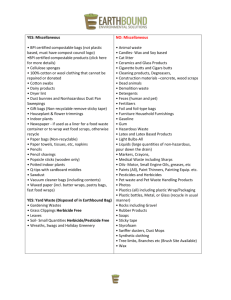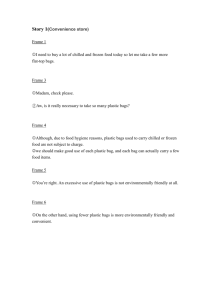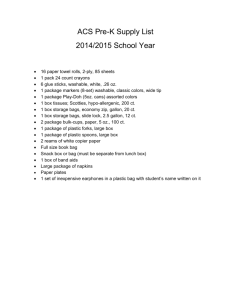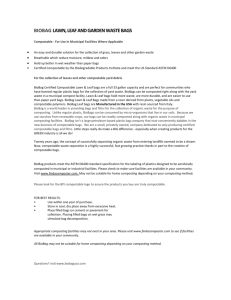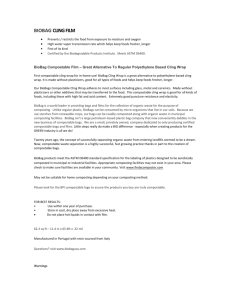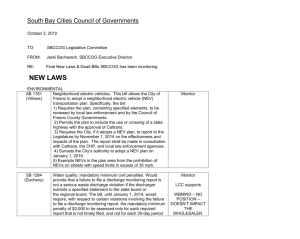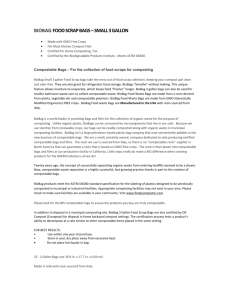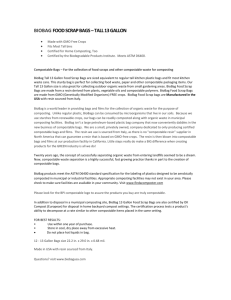Compostable Bags Law FAQ - Solid Waste Management
advertisement
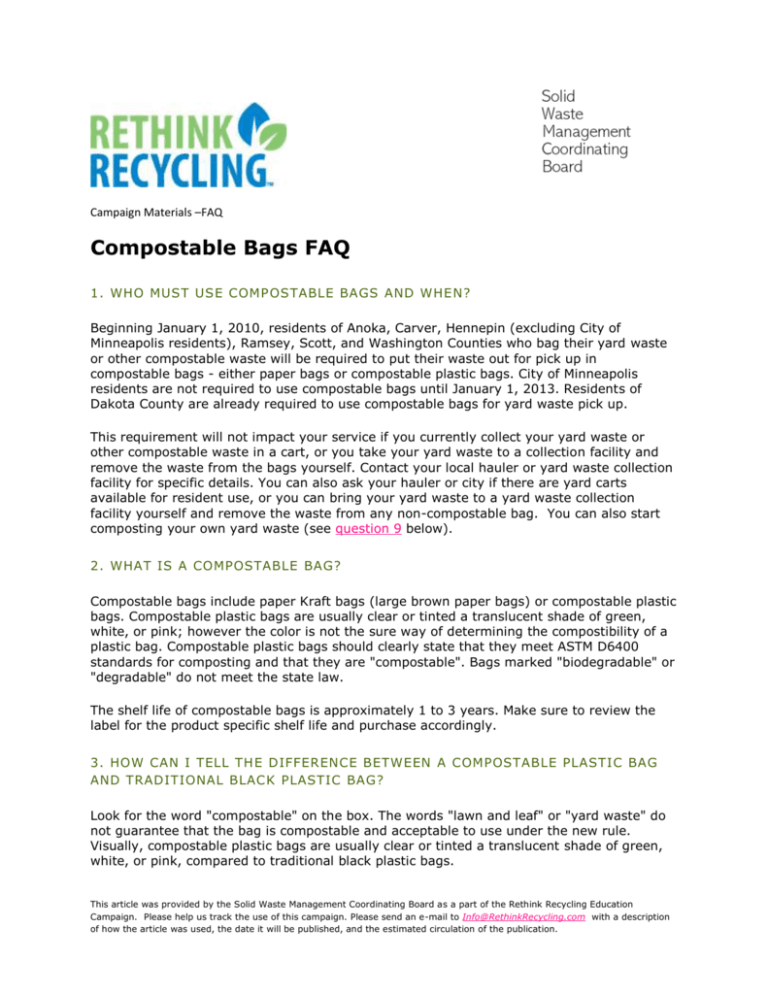
Campaign Materials –FAQ Compostable Bags FAQ 1. WHO MUST USE COMP OSTABLE BAGS AND WHE N? Beginning January 1, 2010, residents of Anoka, Carver, Hennepin (excluding City of Minneapolis residents), Ramsey, Scott, and Washington Counties who bag their yard waste or other compostable waste will be required to put their waste out for pick up in compostable bags - either paper bags or compostable plastic bags. City of Minneapolis residents are not required to use compostable bags until January 1, 2013. Residents of Dakota County are already required to use compostable bags for yard waste pick up. This requirement will not impact your service if you currently collect your yard waste or other compostable waste in a cart, or you take your yard waste to a collection facility and remove the waste from the bags yourself. Contact your local hauler or yard waste collection facility for specific details. You can also ask your hauler or city if there are yard carts available for resident use, or you can bring your yard waste to a yard waste collection facility yourself and remove the waste from any non-compostable bag. You can also start composting your own yard waste (see question 9 below). 2. WHAT IS A COMPOSTABLE BAG? Compostable bags include paper Kraft bags (large brown paper bags) or compostable plastic bags. Compostable plastic bags are usually clear or tinted a translucent shade of green, white, or pink; however the color is not the sure way of determining the compostibility of a plastic bag. Compostable plastic bags should clearly state that they meet ASTM D6400 standards for composting and that they are "compostable". Bags marked "biodegradable" or "degradable" do not meet the state law. The shelf life of compostable bags is approximately 1 to 3 years. Make sure to review the label for the product specific shelf life and purchase accordingly. 3. HOW CAN I TELL TH E DIFFERENCE BETWEEN A COMPOSTABLE PLASTIC BAG AND TRADITIONAL BLACK PLASTIC BAG? Look for the word "compostable" on the box. The words "lawn and leaf" or "yard waste" do not guarantee that the bag is compostable and acceptable to use under the new rule. Visually, compostable plastic bags are usually clear or tinted a translucent shade of green, white, or pink, compared to traditional black plastic bags. This article was provided by the Solid Waste Management Coordinating Board as a part of the Rethink Recycling Education Campaign. Please help us track the use of this campaign. Please send an e-mail to Info@RethinkRecycling.com with a description of how the article was used, the date it will be published, and the estimated circulation of the publication. The Biodegradable Products Institute (BPI), provides an independent certification program for products that meet all requirements of the ASTM D6400 standard, which is the standard required by this new law. BPI uses independent approved labs and reviewers and is not based upon manufacturer's claims. The following logos for certified compostable plastic mean that the bag meets standards required under the law to be considered compostable and are acceptable under this new requirement: (USA) (Europe) 4. WHAT IS THE DIFFERENCE BETWEEN "OXO-BIODEGRADABLE" AND "COMPOSTABLE"? Oxo-biodegradable refers to a material that is made from plastic that, over time, will break down into smaller pieces of plastic but never fully degrade. Compostable materials, on the other hand, are made from plant-based materials and will completely biodegrade in a short period of time in a commercial composting operation. Oxo-biodegradable bags, often labeled "degradable" or "biodegradable" are not permitted under this new law. Only compostable bags are allowed. 5. WILL THE COMPOSTABLE BAGS START TO BR EAKDOWN IF IT RAINS OR IF THEY ARE STORED FOR A LONG PERIOD OF TIM E? The technology used to make compostable bags has improved greatly. The first compostable bags made years ago did tend to break down when stored too long on a shelf or if they came in contact with any moisture. Today, we have much higher-quality bags that have longer shelf lives and can hold up better to outdoor conditions. You will likely notice a difference in brands, so if you don't like one type that you use, try another and it may work better. This article was provided by the Solid Waste Management Coordinating Board as a part of the Rethink Recycling Education Campaign. Please help us track the use of this campaign. Please send an e-mail to Info@RethinkRecycling.com with a description of how the article was used, the date it will be published, and the estimated circulation of the publication. 6. WHY IS USING COMP OSTABLE BAGS IMPORTA NT? Once your yard waste or source separated compostable waste is picked up, it is delivered to a compost facility. Waste received at composting facilities in regular plastic bags must be debagged, which increases costs and the chance that plastic bags will be blowing around on site causing a safety hazard and litter problem. Some compost sites shred the bag and its contents and attempt to screen the torn pieces of plastics later. Unfortunately not all plastic shreds can be screened out, which reduces the value and quality of the finished compost. 7. WHERE CAN I BUY C OMPOSTABLE BAGS? Most home improvement, grocery and hardware stores now carry compostable bags. If you don't see them at your local store, ask an employee. Many store owners are just learning of this requirement and may appreciate the customer request. Compostable bags tend to cost slightly more than the traditional black plastic bags here in Minnesota; however, given the new demand, prices may decrease over time. 8. WHEN DO I HAVE TO USE COMPOSTABLE BAGS ? Compostable bags are required for use with curbside yard waste and compost collection (unless you use a cart from your hauler). So any yard waste, food waste, organics, or other compostable material must be placed in a compostable or kraft bag, or in a cart when collected at the curb. 9. WHAT ARE THE BENEFITS OF USING COMPOS T? Benefits of using compost include: • Saving natural resources; • Reducing soil erosion; • Preventing polluted storm water runoff from contaminating our wetlands, lakes, and streams; and • Providing a valuable soil amendment product that can be used to enrich the soils of our community. You can read more about composting on our yard waste page. 10. WHAT HAPPENS IF I DO NOT USE A COM POSTABLE BAG? If you do not use a compostable bag, kraft bag or a cart from your hauler for yard waste or other compostable waste, your hauler will not collect your waste. If your yard waste is left at the curb for pick-up in a black plastic bag they will not collect it. Compost drop-off sites will also require the material to be removed from non-compostable bags and you will be required to take the bag with you. This article was provided by the Solid Waste Management Coordinating Board as a part of the Rethink Recycling Education Campaign. Please help us track the use of this campaign. Please send an e-mail to Info@RethinkRecycling.com with a description of how the article was used, the date it will be published, and the estimated circulation of the publication.
